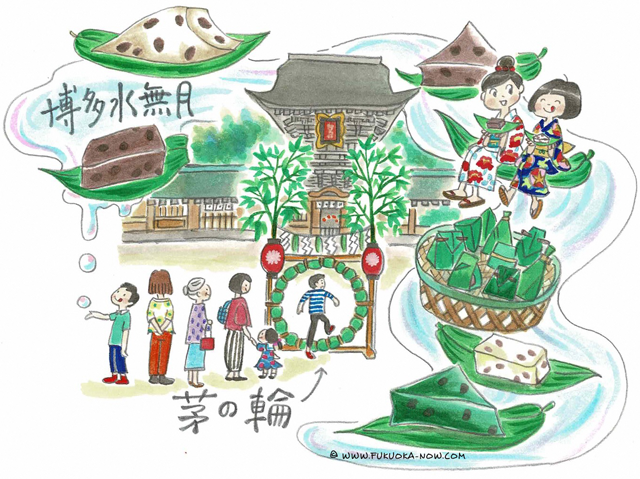Hakata Culture vol.160
Nagoshi no Harae and Chinowa-kuguri: Summer Purification Rites

Every year in June and July, shrines around Japan perform an ancient purification rite called Nagoshi no Harae or Chinowa-kuguri. This is originally one of two Shinto rituals referred to as ōharae ("great purification”) held every six months (once in June and once in December) to ward off bad luck and pray for health.
The ritual would not be complete without a large chinowa ring made from chigaya (cogon grass) that visitors must pass through three times to ward off bad luck. The practice of chinowa-kuguri can be traced back to the story of Somin Shorai from The Chronicles of Japan. Despite being poor, Somin Shorai opened up his home to a traveler who was looking for a place to spend the night. This traveler was actually the god Susanoo-no-Mikoto, and he taught Somin Shorai how to make a chinowa. By wearing this lucky charm, he was later able to escape a plague that swept through his village.
At Fukuoka’s famous Hakozaki Shrine, the ōharae is held on June 30 followed by Nagoshi no Harae on the last weekend of July. These rituals are also held at other local shrines including Sumiyoshi Shrine, Atago Shrine, and Torikai Hachimangu. These summer rituals are not associated with a specific shrine, so many shrines perform them. If you happen across a chinowa at your local shrine, be sure to pass through it for good luck.
In Kyoto, the long-standing tradition is to eat a Japanese sweet called minazuki on the day of Nagoshi no Harae to ward off back luck. Drawing on this, some confectioners in Fukuoka offer minazuki for a limited time in the summer. The basic rule is that minazuki must be made from red beans and bracken flour and wrapped in bamboo leaves, but there are many variations on the theme. When minazuki is “in season,” it is fun to try each shop's unique twist on this traditional sweet.
夏越の祓(なごしのはらえ)と茅の輪(ちのわ)くぐり
毎年6月から7月にかけて、全国各地の神社で「夏越の祓」「夏越祭」、あるいは「茅の輪くぐり」と呼ばれる行事が行われます。もともとは「大祓(おおはらえ)」と呼ばれる神道の儀式で、人々の厄を払い、健康を祈願するものです。大祓は半年に一度行われ、6月末に行われるものが「夏越の祓」、12月末に行われるものが「年越の祓」と呼ばれ、2つでセットになっています。
この儀式に欠かせないのがチガヤで編んだ茅の輪で、境内に設置された茅の輪を3回くぐることで厄を払います。茅の輪くぐりの起源は日本書紀に出てくる蘇民将来(そみんしょうらい)の話です。蘇民将来は貧しいながらも一夜の宿を求めた旅人を温かくもてなしました。実はこの旅人はスサノオノミコトで、その教えに従って茅の輪を身につけたところ疫病から逃れたというものです。
福岡市内の有名な神社としては、筥崎宮で6月30日に大祓式が行われ、7月末の土日に夏越祭が行われます。このほかにも住吉神社、愛宕神社、鳥飼八幡宮など、いろいろな神社で大祓や夏越の祭が行われています。夏越の祓や茅の輪くぐりは特定の神社の祭ではないため、身近な神社でも行われていることがあります。近くの神社で茅の輪を見かけたら、ぜひくぐってみましょう。
ところで、京都には昔から夏越の祓の日に和菓子「水無月(みなづき)」を食べて邪気を祓う風習がありました。これに習って、福岡の和菓子屋も「水無月」と名づけた季節限定のお菓子をこの時期に作るようになりました。「小豆とワラビ粉を主原料にし、笹で巻く」という決めごとを守ればアレンジは自由。各店が創意工夫を重ねた「水無月」を食べるのも楽しいものです。

